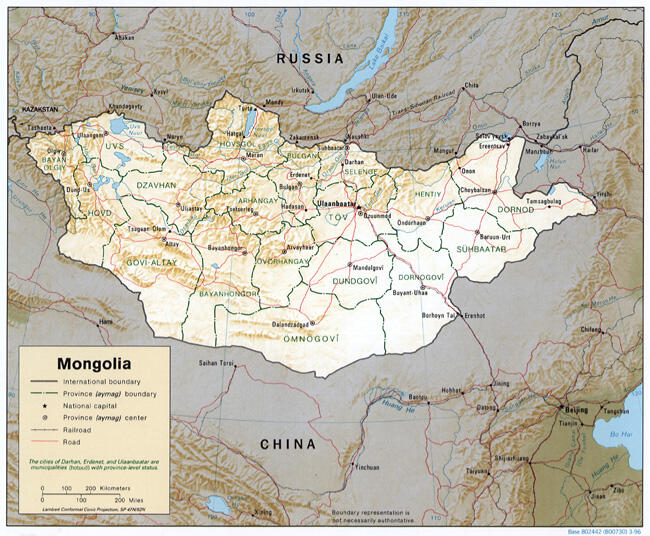Traveling to Mongolia is a truly rewarding experience. The people are friendly and welcoming, the culture and traditions are unique and the landscape is vast and unspoiled.
Mongolia is a country of contrasts. In the capital young people are wearing western clothing and pursuing western forms of entertainment while the elderly are still wearing dels, the traditional Mongolian dress. In the countryside though life is much more traditional with all ages wearing tradtional dress and singing folk songs together at social gatherings.
The contrasts in the environment are endless. The Gobi Desert in the south provides an enthralling landscape of sand dunes; high mountain cliffs with intricate rock formations and flat, rocky plains. The north is quite the opposite. Here we find gushing streams, lush green forests and crystal clear lakes. Everywhere in Mongolia the people are exceptional, however. The culture of the country is one of warmth and hospitality. A stranger is immediately a welcomed friend and the delightful comfort of the ger (yurt) is remarkable.
The pace of life is slow compared to western standards and the people are in no hurry. The countryside people are very interested in westerners and will often like to engage you in long conversations.
When traveling in Mongolia one must allow for a certain degree of patience and be open to changes and spontaneity. But whatever happens it will turn out to be an unforgettable adventure with a happy end for those involved. Mongolia is a most unspoiled country with a most remarkable people.

Climate
Mongolia is a land of extremes. The weather can be very changeable. MongoliaCanoeing times it´s Tours to coincide with the warmer summer months in Mongolia – from early June to the middle of September. Average temperatures at this time range from 13 – 17 Celsius, reaching 35-40 Celsius in July and August.
There is a short rainy season from July to September with a maximum rainfall around 76mm in July. The weather can still be rather unpredictable during the summer months. The days are generally warm and sunny and the nights cool. In spring, Mongolia can be very windy and the winters can be arctic. Please take warm and waterproof clothing. Also, be prepared for the cold nights.
Geography
Mongolia is a large land-locked country about three times the size of France or one fifth of the USA. It is situated in the north of the central Asia and covers over 1.5 million square km of territory. It is a country with steppe, desert and high mountains. It is one of the highest countries in the world with an average elevation of 1580 meters above sea level.
In the north of Mongolia there are three main mountain ranges – the Khangai Mountain Range, Khentii Mountain Range and the Khuvsgul Sayany Mountain Range. The Altai Mountain range lies 4500m above see level and has eternal snow covered peaks and glaciers. It lies from the west to the south- east of the country. The Altai Mountains are divided into the Mongol Altai Mountains and the Gobi Altai Mountains. Much of the country is covered by grass and less than 10% of the land is forested.
The southern third of the country is dominated by the Gobi Desert. Between the Altai and Khangai Mountains there is a vast steppe with low hills and desert which is called the North Altai Gobi. The part of the Gobi Desert from the south of the Altai mountain to the Chinese border is called the South Altai Gobi and the Gobi which is in the east of Altai Mountains is called the East Gobi.
The greatest river in Mongolia is the Selenge which flows northwards into Lake Baikal. Except the Khovd river all the rivers that we travel are it´s tributaries.
Fauna
Mongolia has a very rich wild life. There are animals inhabiting all areas of the country from the high mountain taiga to the desert. Today there are 56 species of fish, 6 species of amphibians, 22 species of reptiles, 430 species of birds, 130 species of mammals, which have been catalogued. There are some very rare wild animals such as Bactrian (two-humped) camel, Wild horse, Gobi bear, Saiga Antelope, Goitered Black tailed Gazelle, Argali-Wild Mountain Sheep and Snow Leopard. There is an abundance of bird life that can be seen including many interesting and rare birds such as Bearded Vulture, Imperial Eagle, Saker Falcon and Altai Snowcock.
Religion
The most prominent religion in Mongolia is Buddhism with a total of 90% of the population as Buddhists. The sect of Buddhism that is practiced is Lamaism, which is essentially Tibetan Buddhism.
For visitors to the temples and monasteries the following is a brief etiquette guideline:
- do not step in front of the monks during chanting in the temples
- take small denomination notes in local currency to leave as offerings at the shrines
- spin prayer wheels in clockwise direction and always walk around the shrines or burial sites in a clockwise direction
- do not take photographs in the temples unless local permission has at first been obtained
Many of the temples and monasteries were destroyed during the years of the Communist Regime in Mongolia. A good many of them are being lovingly restored now and some of them are again functioning.
There is a small minority group inhabiting Khuvsgul, Khordol, and the Sardagiin mountains who still keep the Shamanistic traditions. Another minority group in Mongolia, the Kazakhs, approximately a hundred thousand people, are Muslims. They live in the far western province of Bayan Olgii and are Sunni Muslims.
Currency
The official currency of Mongolia is the togrog (MNT). As of March 2024, 1 USD was worth approximately 3000 togrogs. US dollars are readily accepted in most hotel gift shops and souvenir shops in the town.
There is plenty of currency exchange shops that offer far better rates than the airport, hotel cashdesks and banks. We recommend carrying a certain amount of US dollar cash. Please ask your bank to provide dollar currency dated 2005 or later, as currency dated earlier may be rejected by currency exchange places. Most hotels, restaurants and tourist shops now accept international credit cards. Local shops and markets accept only togrogs.

